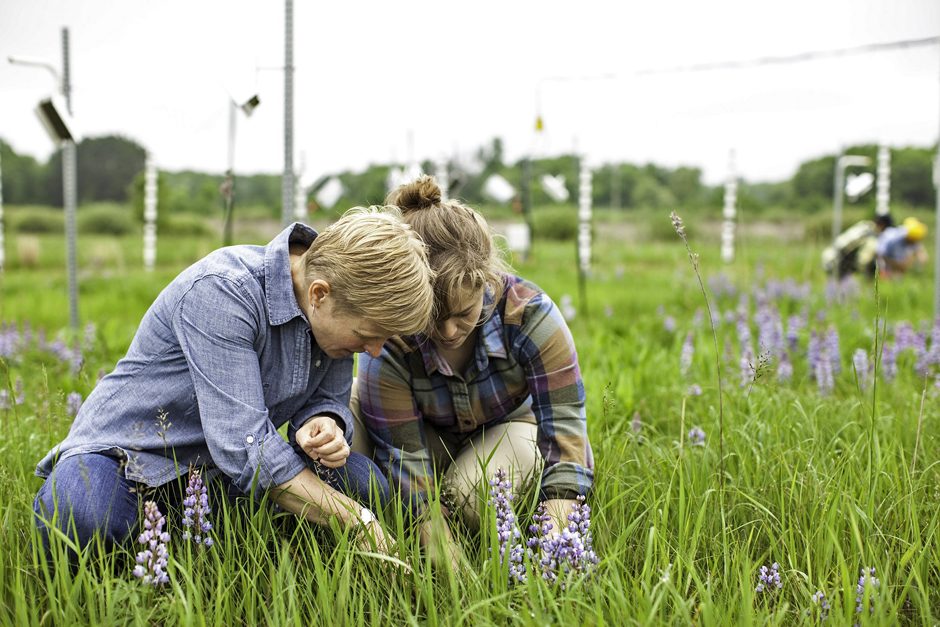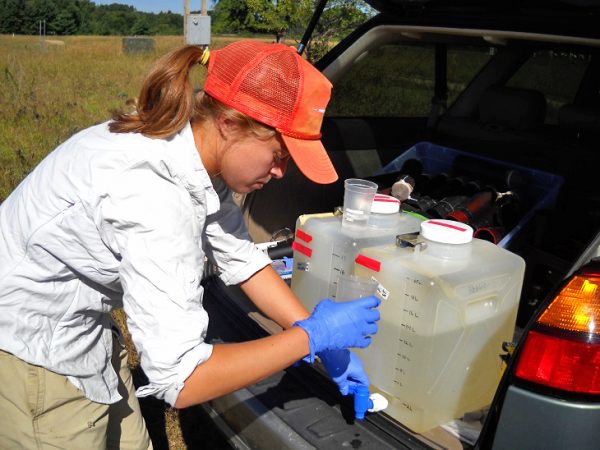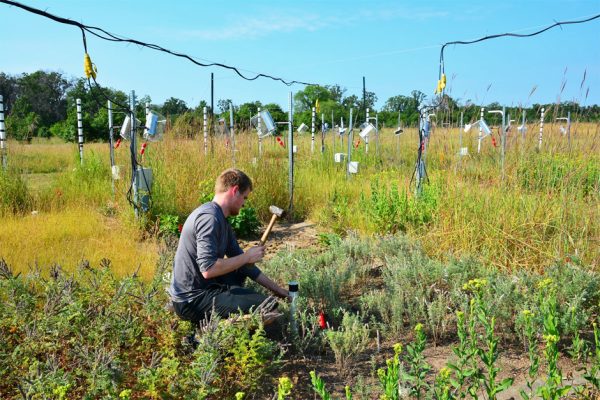University of Minnesota’s Cedar Creek Ecosystem Science Reserve: Making Significant Contributions to Ecosystem Studies and Environmental Monitoring since the 1940s
 PI Sarah Hobbie and Graduate student Clare Kazanski work in BioCON (Photo Credit: Jonathan Pavlica, 2013 [CC BY-SA 4.0, UMN website])
PI Sarah Hobbie and Graduate student Clare Kazanski work in BioCON (Photo Credit: Jonathan Pavlica, 2013 [CC BY-SA 4.0, UMN website])Cedar Creek Ecosystem Science Reserve is home to several very important research efforts that have made it into the history books. Cedar Creek was once the stomping ground of Raymond Lindeman, also known as “The Grandfather of Ecosystem Ecology.” Cedar Creek was also the first place where automated telemetry of animals’ movements was utilized. It’s also home to the world’s longest biodiversity experiment, the longest-running elevated CO2 experiment, one of the longest fertilization studies and one of the longest-running burn studies to maintain an oak savanna. Cedar Creek is also the global headquarters of the Nutrient Network.
“The Cedar Creek Ecosystem Science Reserve Biological Field Station is under the college of biological sciences here at the University of Minnesota,” says Forest Isbell, Associate Director of Cedar Creek Ecosystem Science Reserve, Assistant Professor of the Department of Ecology, Evolution, and Behavior at the University of Minnesota, and Associate at the University of Minnesota’s Institute on the Environment. “Our main interests are research, education and conservation, and we’ve been around since 1942. We have about 75 years of research data on, for example, Cedar Bog Lake, where Raymond Lindeman did pioneering biomass pyramids and living and non-living nutrient flow studies.” Lindeman’s studies looked at how materials and energy flowed through the system. “He looked at how the lake lives and breathes,” says Isbell.
Cedar Creek is part of the GLEON, the Global Lakes Ecological Observatory Network, as well as the OBFS. Other studies done at Cedar Creek include James Cotner’s work on carbon fluxes in and out of the Cedar Creek system.

Graduate student Clare Kazanski measures nutrient solutions in the field. (Photo Credit: Susan Barrott, 2013 [CC BY-SA 4.0, UMN website])
Isbell also does surveys using DJI Matrice 600 Pro drones to monitor plant diversity. The drones take hyperspectral images which allow identification of species of interest and monitoring of their growth. These drones are large enough to carry heavy payloads, about three times the size of a digital SLR. They have hyperspectral sensors and are flying LiDAR units that generate a 3D point cloud that can monitor change in vegetation. Thermal sensors on the drone can also be used to quantify deer densities. Traditional scat and tracking surveys are also done for comparison. There are also sensors for plants and soil moisture, made by Meter (formerly Decagon). LiCOR manufactures the sensors that are used for photosynthesis data. These data are used to determine vegetation responses to natural disturbances like fire and how global climate change is altering the ecosystem.
Cedar Creek is part of the LTER program sponsored by NSF, one of only two dozen such sites. Some of the long term experiments that Cedar Creek is best known for include the world’s longest biodiversity experiment, led by Dave Tilman which began in 1994 and is still active; the longest-running elevated CO2 experiment started in 1997, led by Peter Reich and Sarah Hobbie; one of the longest fertilization studies which started in 1982, also led by Dave Tilman; and the longest-running burn study to maintain oak savanna, started in 1964, and is currently led by Peter Reich.
“The burn study has recently added bison grazing. We’ve found that the bison reduce fire intensity by grazing on the bluestem and switchgrass. This helps the oak seedlings because if the grasses are still there, the burning is hotter and it can be too hot for the oak seedlings. On the other hand, if there’s no fire, maples can shade out the oak trees and they never get going. So a balance needs to be achieved for good oak growth,” says Isbell.

Interns taking soil cores in e141 the BioCON experiment. (Photo Credit: Jacob Miller, 2014 [CC BY-SA 4.0, UMN website])
Another notable sight at Cedar Creek is Blanding’s turtle, a rare turtle that has been spotted in the oak savanna habitat. “Cedar Creek is so diverse. We have 1 out of every 1,000 plant and insect species in the world here, with 500 plant species alone,” Isbell says. “John Haarstad has thousands of insect pictures taken at Cedar Creek as well.”
Distinguished as the global headquarters of the Nutrient Network, Cedar Creek nutrient studies, run by Elizabeth Borer and Eric Seabloom, focus on plant diversity and productivity. Studies involve simulating nitrogen deposition and seeing how much that reduces diversity. Plant productivity studies involve assessing where nitrogen deposits have an effect.
Cedar Creek is also part of Drought-Net, a global network for studying drought via drought simulation.
Isbell has enjoyed his position at Cedar Creek. “I’m interested in plant diversity, and Cedar Creek is one of the best places anywhere to research plant diversity. There is so much interesting work being done here. One of the things we are doing is manipulating global change factors that lead to extinction to gain a better understanding of what the future may hold. We are also looking at timber and forage production. Cedar Creek is open for research studies. I encourage any group who wants to study here to contact us,” Isbell says.
Cedar Creek Ecosystem Science Reserve is operated by the University of Minnesota and the Minnesota Academy of Science and is about 50 km north of Minneapolis and St. Paul.
Lab webpage | Cedar Creek Ecosystem Science Reserve | Aerial photos of Cedar Creek (1966)




0 comments